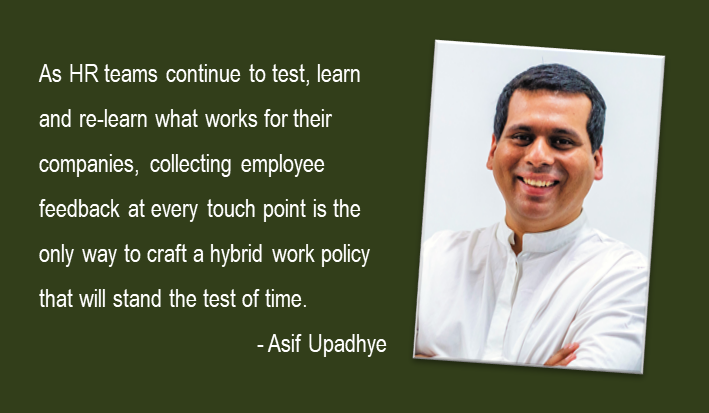As people start slowly inching back to their offices (for the second, third or probably fourth time), HR teams have a crucial role to play in supporting an evolving hybrid workforce. I came across an interesting report by Gartner titled “A Business Case for the Hybrid Workforce” which revealed that although only 30% of employees worked remotely pre-COVID, this number has now increased to a whopping 78% of employees who hope to work either remotely or have the option to operate via a hybrid work model.
Hybrid work can no longer be deemed as the ‘future of work’ for the simple reason that companies are swiftly adopting hybrid models to suit the needs of both their business and their people. The challenge however is to introduce not just a remote-working or hybrid policy, but to also ensure that there is very little room for error. Quite fascinatingly, the second-most-common ‘location’ for hiring posts on LinkedIn is ‘remote work’. At a base level, shifting the way we view hybrid work needs to change. Rather than seeing it as a temporary option just until the pandemic ends, it needs to be regarded as a way to maintain organisational flexibility, safety and efficiency.
As HR teams continue to test, learn and re-learn what works for their companies, collecting employee feedback at every touch point is the only way to craft a hybrid work policy that will stand the test of time. Balancing business and employee needs is a delicate area that requires a combination of empathy, a deep understanding of an organisation’s short and long-term goals and the ability to pivot at any moment in time. Whether your employees return to office full-time, work remotely or operate via a hybrid work model, prioritising their physical and psychological safety needs to remain a focal point. Despite this, the one question that CEO’s, leaders, employees and HR personnel seem to be asking is:
‘What do we really need to include in a hybrid policy?’
In my opinion, before you dive into the nitty-gritties of formulating a brand-new policy, you need to define exactly why your company is shifting to a hybrid work model. Gathering opinions and facilitating open discussions to gauge the pulse of what your people think will be a massive advantage when you finally get down to drawing up and executing the policy. As a second step, consider the business’ top priorities. While this process might not involve employees across all levels in the company, HR teams will need to work closely with the C-suite in order to answer the next question:
‘What type of employer and company do you want to be?’
Going back to the drawing back and chalking out your company’s core vision and mission will help set up a solid starting point for the journey to achieve your business goals and enable a happy work environment. As you’ve probably guessed by now, the third part of this process involves responding to questions ranging from
‘Who can avail the hybrid work policy?’, ‘How should this be communicated to employees?’, ‘What is expected from employees both in terms of productivity and meeting business goals?’
If the war on talent has taught us one thing, it’s the fact that HR teams needs to advocate for hybrid ways of working in order to deliver the right employee experience. In India alone, 69% of employees would opt for flexibility when it comes to their work schedules. The growing concept of ‘work from anywhere’ is evident from the way that an increasing number of employees have begun to log in from remote destinations of their choice.
This brings me to the final step of setting up a hybrid work policy, which unmistakably requires capitalising on technology. Deploying human capital management tools that go beyond just managing employees is an important piece of the puzzle. Utilising tech that enables learning and development programs, encourages people to communicate seamlessly and provides leaders with a birds-eye view of how each arm of the business interacts with the other is the real ‘future of work’. Although HR teams undoubtedly have their work cut out for them, having a laser-sharp focus when aligning your business and people goals will set your company up for a hybrid work policy that truly works for all.
The views and opinions published here belong to the author and do not necessarily reflect the views and opinions of the publisher.




Be the first to comment on "Hybrid policy: Why HR teams must balance business and employee needs"